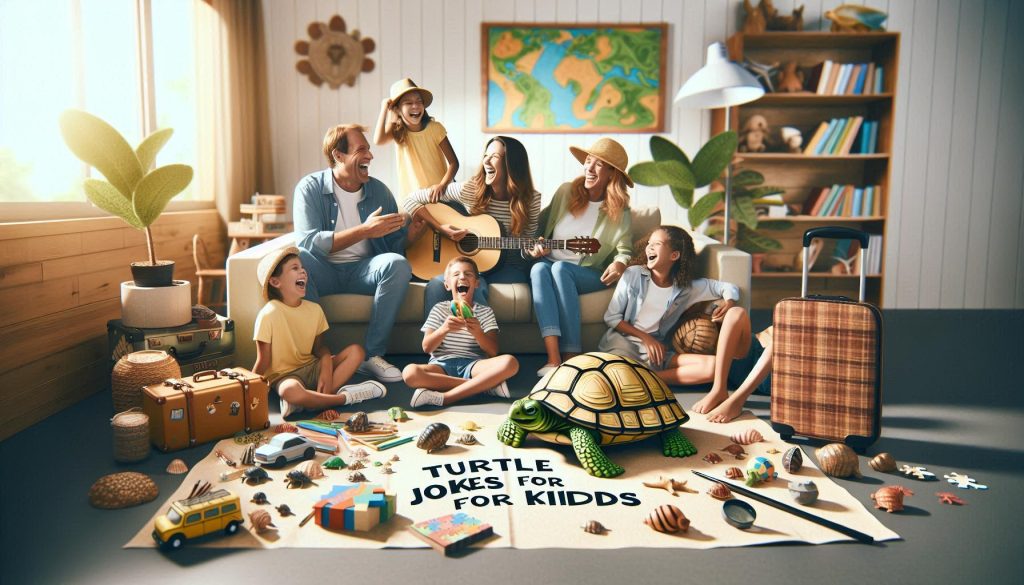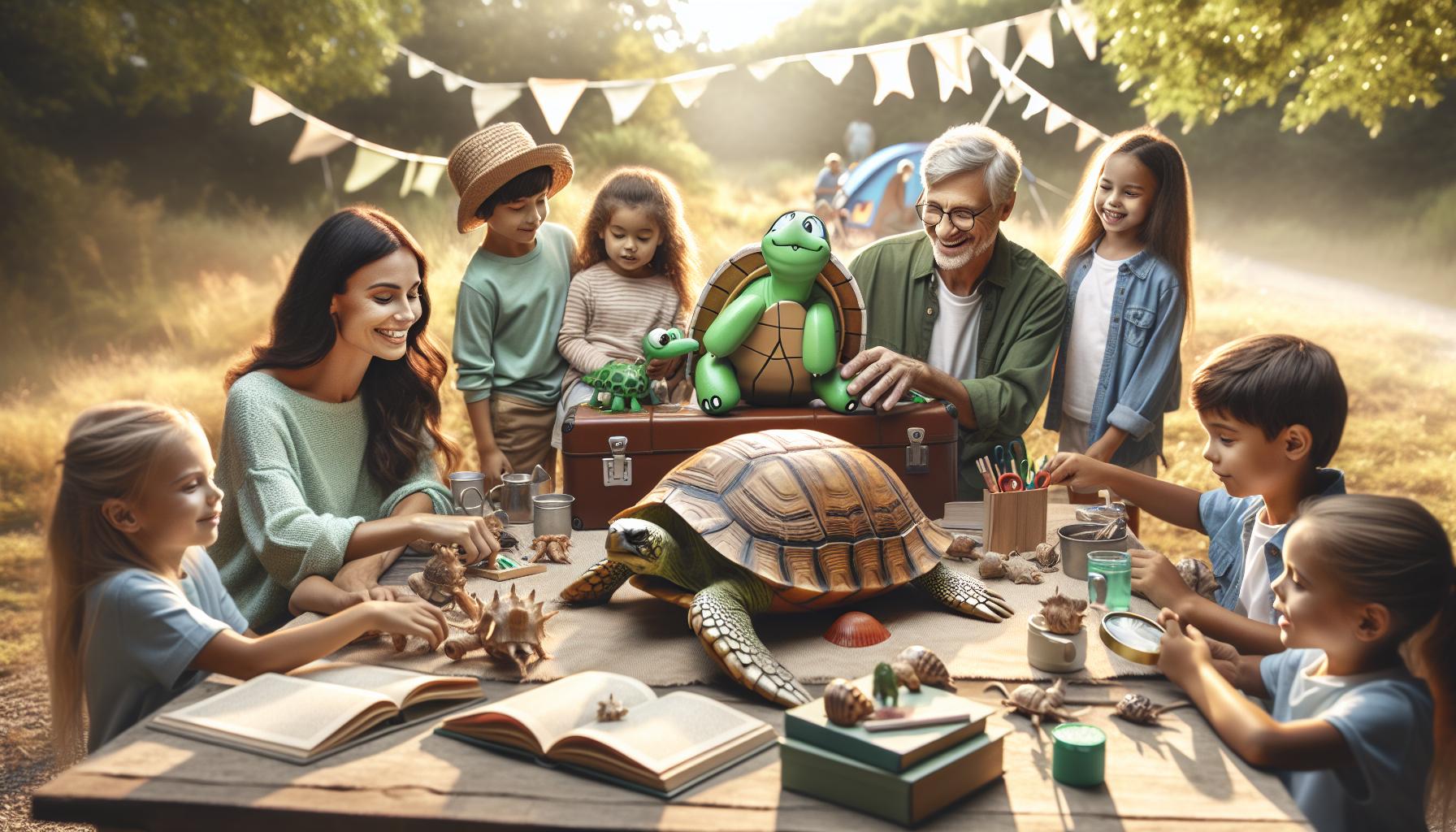Turtle Jokes for Kids: Shell Out Some Lighthearted Humor
Looking to add a splash of laughter to your day? Dive into the delightful world of ”Turtle Jokes for Kids: Shell Out Some Lighthearted Humor”! Whether you’re a parent, teacher, or just young at heart, these clever quips and pun-tastic jokes are sure to tickle your funny bone. Perfect for sharing at parties, during road trips, or simply to brighten up a dull afternoon, our collection of turtle-themed humor is hear to remind us all that laughter is the best shell-abration! So, gather ’round and get ready to chuckle; these turtle jokes will have you moving at a speed that’s anything but slow! 🐢✨
Understanding the Appeal of turtle Jokes in Children’s Humor
Children’s humor often reflects their developmental stage, and turtle jokes hold a unique charm that captivates young audiences. These jokes typically feature simplistic setups and punchlines, making them easy to understand and share among peers. With their gentle puns and delightful wordplay, turtle jokes promote laughter without the need for complex explanations. They serve as a powerful tool for fostering social connections and encouraging children to engage in group interactions.
Moreover,the imagery associated with turtles adds an extra layer of enjoyment. Turtles are often portrayed as slow, comical creatures, which resonates with kids who appreciate anything that breaks the norm. This can be highlighted in the following ways:
- Relatable Themes: Kids often relate to the idea of being cautious or a bit slow, mirroring their own experiences of learning and growing.
- Visual Appeal: The cute and colorful depiction of turtles in illustrations or animations enhances the humor, making it more appealing.
- Timelessness: Turtle jokes have a classic quality that transcends generational boundaries, allowing parents to share these jokes with their children.
To summarize the benefits of turtle jokes in children’s humor, we can look at this table:
| Aspect | Benefit |
|---|---|
| Understanding | Simple setups make jokes easy to grasp. |
| Social Connection | Sharing jokes fosters friendships. |
| Imagination | Encourages creative thinking through humor. |
In essence, the appeal of turtle jokes lies not just in their humor, but also in their broader implications for social interaction and cognitive development. By engaging with these lighthearted quips, children not onyl enjoy a good laugh but also learn valuable communication skills, crucial for their growth.
The Importance of Humor in Early Childhood Development
incorporating humor into early childhood development is not just about eliciting laughter; it plays a profound role in enhancing social, cognitive, and emotional growth. When children interact with humor, especially through jokes and playful language, they develop critical thinking and reasoning skills.Understanding humor requires children to grasp language nuances, recognize timing, and make connections, which contributes to their overall cognitive development.
Moreover, humor serves as a powerful tool for social bonding. When kids laugh together, they cultivate relationships and strengthen peer connections. Sharing jokes, such as the delightful turtle-themed puns, encourages cooperative play and helps children learn essential social skills, like taking turns and engaging in conversations. This playful interaction fosters a sense of community while boosting self-esteem and resilience, vital attributes as they navigate both friendships and challenges.
Additionally, humor can be an effective mechanism for emotional regulation. Children who engage with funny content are more likely to cope with stressful situations through laughter. By framing challenges humorously, they learn to view difficulties as manageable rather than intimidating, cultivating a resilient mindset. Integrating jokes into daily interactions not only brightens the mood but also serves as an invaluable tool for soothing frustrations and promoting emotional well-being.
| Benefits of Humor | Examples |
|---|---|
| Cognitive Development | Understanding turtle jokes requires reasoning skills. |
| Social Skills | Sharing jokes promotes cooperative play. |
| Emotional Regulation | Laughter can reduce anxiety in stressful moments. |
A Collection of Family-Friendly Turtle Jokes to Enjoy Together
Gather the family around for some good old-fashioned laughs! Here’s a delightful collection of turtle jokes that are sure to entertain kids and adults alike. These shell-tastic jokes are perfect for lightening the mood during family game nights or just making a regular day a bit more fun.
- What do you call a turtle that takes up photography? A shell-fie expert!
- Why did the turtle cross the road? To get to the shell station!
- what do you get if you cross a turtle with a porcupine? A slowpoke!
- Why don’t turtles use cell phones? Because they can’t get a good signal! They prefer shell-mailing!
To make it even more engaging, why not try a little trivia alongside the jokes? Here’s a fast table featuring some fun turtle facts paired with a joke:
| Fact | Joke |
|---|---|
| Turtles can breathe through their bottoms! | Why did the turtle sit on the fence? Because it wanted to be a little shellfish! |
| Some turtles can live for over 100 years. | What do turtles do when they argue? They get into a shell-and-tell! |
These jokes not only spark giggles but also encourage kids to appreciate the quirks of turtles. Sharing laughter as a family builds bonds and creates cherished memories. So, let the shells roll and enjoy some laughter together!
How Turtle Jokes Can Foster Creativity and Imagination
Turtle jokes are not just a source of laughter; they play a meaningful role in enhancing children’s creativity and imagination. Humor has a unique way of breaking down barriers, allowing young minds to explore and express their thoughts freely. By incorporating silly situations and puns related to turtles, children can delve into a world where anything is possible, encouraging them to craft their own stories and scenarios.
Here are a few ways in which turtle jokes stimulate creativity:
- Storytelling Inspiration: A whimsical turtle joke can spark ideas for a story. Such as, the joke “Why did the turtle cross the road? To get to the shell station!” coudl inspire kids to imagine a turtle’s adventurous journey, incorporating elements of travel and exploration.
- Character Development: Jokes often personify animals, giving children a chance to invent personalities and backstories. A turtle who enjoys dancing because “he has the moves like a tortoise” could lead to a character that children want to further develop into a fun story or play.
- Problem-Solving Skills: Jokes that incorporate a twist, such as “What do you get when you cross a turtle and a giraffe? A slowpoke!” encourage children to think critically about how two different beings can interact in a world of their own making.
Moreover, fostering creativity through humor can enhance cognitive skills. Children’s laughter and engagement with jokes can enhance their emotional intelligence, helping them to understand context, cues, and the feelings behind the humor. This interactive process not only cultivates imagination but also enriches their ability to communicate and connect with others.
| benefits of Turtle Jokes | Examples |
|---|---|
| Enhances Storytelling | Inspires tales of adventures |
| Promotes Character Creation | Develops unique characters |
| Encourages Critical Thinking | Explores interactions and consequences |
| Boosts Emotional Connectivity | Understands humor in different contexts |
Tips for Parents: Using Jokes to Enhance Learning and Communication
Using humor, such as jokes, can significantly enhance communication and learning in children. For parents, sharing turtle jokes not only serves as a fun activity but also promotes creativity and critical thinking. Here are some ways you can integrate jokes into your children’s learning routine:
- Encourage Engagement: Ask your kids to come up with their own turtle jokes after sharing a few. This can stimulate their imagination and encourage them to think creatively.
- Focus on Language Skills: Discuss the language used in the jokes. explore the puns, wordplay, and sentence structure. This can improve their vocabulary and comprehension.
- Foster social Skills: Share jokes with friends and family during gatherings. This not only boosts confidence in public speaking but also strengthens social bonds.
For a fun twist, you might even create a little “joke of the week” tradition, featuring different turtle jokes. This can inspire your child to look forward to learning time. Here’s an example of a simple format you could follow:
| Turtle Joke | Response/Clarification |
|---|---|
| Why did the turtle cross the road? | To get to the other tide! |
| What’s a turtle’s favorite pizza topping? | Anything, as long as it’s a little shellfish! |
| Why don’t turtles like to play poker? | They can’t handle the shell shock! |
integrating jokes into everyday interactions can create a more relaxed atmosphere and open doors for discussions. By making learning enjoyable, parents can definitely help foster a love for knowledge and communication in their children.
The role of Animal Humor in Building Social Skills among Kids
Animal humor, especially jokes involving turtles, serves as a fantastic tool for children to engage socially. When kids share a funny turtle joke with peers, they not only elicit smiles and laughter, but they also create a bridge for conversation. This interaction nurtures skills like active listening and expressive communication, as children learn to gauge responses and adjust their delivery based on their audience’s reactions.
Through the simple act of telling a joke, children practice important social skills. For example:
- Building Confidence: Sharing jokes encourages kids to express themselves in front of others, helping to build their self-esteem.
- Social Connection: A shared laugh fosters bonds among peers,promoting camaraderie and teamwork.
- Understanding Timing: Good joke-telling requires an understanding of when to deliver the punchline, which helps kids navigate social cues.
Furthermore,using humor as a medium,kids can learn empathy. When they share a joke about turtles, they tune into their friends’ sense of humor and perspective. This practice cultivates emotional intelligence, as they navigate the feelings of amusement or confusion their joke might evoke. for instance:
| Turtle Joke | Response Type |
|---|---|
| Why did the turtle cross the road? | To get to the shell station! |
| What do you call a turtle that likes to play poker? | A shell-raiser! |
In this light, animal humor not only lightens the atmosphere but also lays the groundwork for essential interpersonal skills. Kids learn to share, laugh together, and bond over shared experiences, thus fostering a healthier social environment. This playful approach helps them navigate both childhood friendships and future relationships with ease.
Creating a Turtle Joke Book: Encouraging Kids to Write and Share
Creating a turtle joke book is a fantastic way to engage kids in writing and sharing their own humor. By combining creativity with the joy of laughter, children can learn essential writing skills while expressing themselves in a fun and enjoyable manner. Here are some ideas to nurture their comedic talents:
- Encourage collaboration: Pair up kids to brainstorm joke ideas together. This fosters teamwork and helps them bounce ideas off one another.
- Provide Prompts: Give them starting points like “Why did the turtle cross the road?” to kickstart their imagination and creativity.
- Set Up Writing Workshops: Organize small workshops where kids can share their jokes, receive feedback, and learn from each other’s writing styles.
- Create a Comfortable Sharing Environment: make it clear that all jokes are welcome, no matter how silly. This encourages kids to think outside the box without the fear of criticism.
As kids develop their jokes, compiling them into a book not only provides a tangible end product but also encourages them to think about the structure and flow of humor. They can categorize their jokes into different themes, like knock-knock jokes, puns, or riddles, which adds an element of organization and fun. Here’s a simple table to illustrate how they might structure their contributions:
| Joke Type | Example Joke | Contributed by |
|---|---|---|
| Knock-Knock | Knock, knock! Who’s there? Turtle. Turtle who? Turtle-y awesome joke! | Emily |
| Pun | What’s a turtle’s favorite game? Shell-ter! | Jayden |
| Riddle | What do you get when you cross a turtle and a giraffe? A turtleneck! | Sam |
Through this process,children not only improve their writing skills,but they also learn to appreciate humor and the simple joys it brings. The bonding experience of crafting and sharing jokes will create lasting memories and encourage a love for storytelling that extends beyond the turtle jokes themselves.
Q&A
What makes turtle jokes especially appealing to kids?
Turtle jokes are uniquely appealing to children due to their simple structure and relatable humor. Kids often enjoy humor that is straightforward and easy to understand. The gentle pace and character traits associated with turtles—like being slow and wise—lend themselves to playful puns and jokes that can easily resonate with a young audience. Children find joy in the playful exaggeration of a turtle’s characteristics, which can lead to giggles and laughter.
Moreover, turtle jokes frequently enough play on words, using puns that prompt kids to think creatively about language. As a notable example, a classic turtle pun might involve phrases like “shell” or “slow” in humorous contexts. This can encourage critical thinking as children connect the dots between words and their meanings. Engaging with jokes helps nurture their language skills while contributing to their emotional development through shared laughter and fun with peers or family members.
Why is humor important in child development?
Humor plays a crucial role in child development, offering benefits that extend beyond simple laughter. For starters, engaging with jokes—like those about turtles—can significantly enhance cognitive development. When children hear or create jokes, they are exercising their language skills and learning how to recognize linguistic patterns and meanings. This cognitive leap fosters critical thinking and comprehension skills that are valuable in both academic and social settings.
Along with cognitive advantages, humor is also invaluable for emotional and social development. Sharing jokes allows children to bond with their peers,providing a sense of belonging and community. When kids laugh together, they learn to express themselves and understand the nuances of social interactions. Knowing the appropriate time to use humor is a key social skill, and these playful exchanges can help children navigate friendships more effectively. humor enriches their experiences and strengthens their interpersonal connections.
How can parents and educators incorporate turtle jokes into learning?
Incorporating turtle jokes into the learning environment can be both fun and effective for enhancing engagement in educational activities. One approach is to use joke-telling as a warm-up activity at the start of a lesson. This can definitely help capture students’ attention and create a relaxed atmosphere conducive to learning. For instance, sharing a couple of simple turtle jokes can serve as an icebreaker, leading into a topic on marine biology or animal behavior.
Parents can also encourage creative writing skills by prompting children to create their own turtle jokes. This activity not only fosters creativity but also allows kids to practice their writing and storytelling abilities. Educators might consider developing themed lessons around animals, using turtle jokes to illustrate points about habitats, behavior, or even conservation efforts. Such integration makes the learning process enjoyable and memorable, ensuring that knowledge sticks in students’ minds.
Where can families find a collection of turtle jokes?
Families seeking a collection of turtle jokes can explore various resources, including books, websites, and social media platforms. Many children’s joke books feature sections dedicated to animals, including turtles. Libraries often stock such playful literature, making it accessible for family reading nights or group storytelling sessions, which can encourage family bonding.
Online resources are also abundant. Websites focused on family-friendly humor frequently curate lists of jokes by themes, including turtles. Educational websites that promote literacy and creative thinking might also feature sections on jokes and riddles. Platforms like Pinterest can be valuable for finding visual joke prompts that families can print or use as fun activities. Social media can provide a continuous stream of new jokes and funny content shared by fellow parents and educators, creating a community of humor enthusiasts.
Are turtle jokes suitable for all age groups?
While turtle jokes are primarily targeted toward younger children, the concept of turtle humor can be adjusted to appeal to various age groups.For example, preschool-aged children might enjoy simple, one-liner jokes or silly turtle illustrations. As kids grow older, they can appreciate more complex wordplay and puns that involve a deeper understanding of language. This adaptability means that turtle humor can be enjoyed by a wide audience when framed appropriately.Moreover,beyond children,adults can find enjoyment in sharing these jokes with younger family members. this not only reinforces the parent-child bond but also creates opportunities for adults to connect with children in fun and lighthearted ways. It’s essential, however, for adults to share jokes that are age-appropriate and to encourage children to explore creating their own jokes, stimulating creativity and confidence at any age.
How do turtle jokes align with broader themes of environmental awareness?
Turtle jokes can serve as an engaging entry point to discuss broader themes of environmental awareness and marine conservation with children. By incorporating simple humor about turtles, educators and parents can introduce important topics such as the role turtles play in ecosystems, the threats they face due to pollution, and the need for conservation efforts. This connection can inspire kids to think critically about their impact on the environment and motivate them to take action.
For example, after sharing a funny turtle joke, a parent or teacher might transition into a discussion about how turtles contribute to ocean health or the challenges posed by plastic waste in marine habitats. Through humor,children may feel more connected to the subject matter and be more likely to remember the key messages. Ultimately, turtle jokes not only entertain but also provide a platform for educating children about vital environmental issues in a fun, approachable, and impactful way.
Future Outlook
humor plays a vital role in children’s development, and turtle jokes offer a delightful way to combine fun with learning. By engaging with these lighthearted puns and one-liners, kids can enhance their language skills, social interactions, and creativity—all while enjoying a good laugh. The examples provided not only spark joy but also serve as a reminder of the importance of playful learning. So,whether you’re sharing a turtle joke over dinner or incorporating them into classroom activities,you’re fostering an environment where laughter and learning go hand in hand.Remember, it’s not just about the punchline; it’s about the connections and memories made along the way. So go ahead,shell out some humor,and watch as giggles and smiles fill the air!




